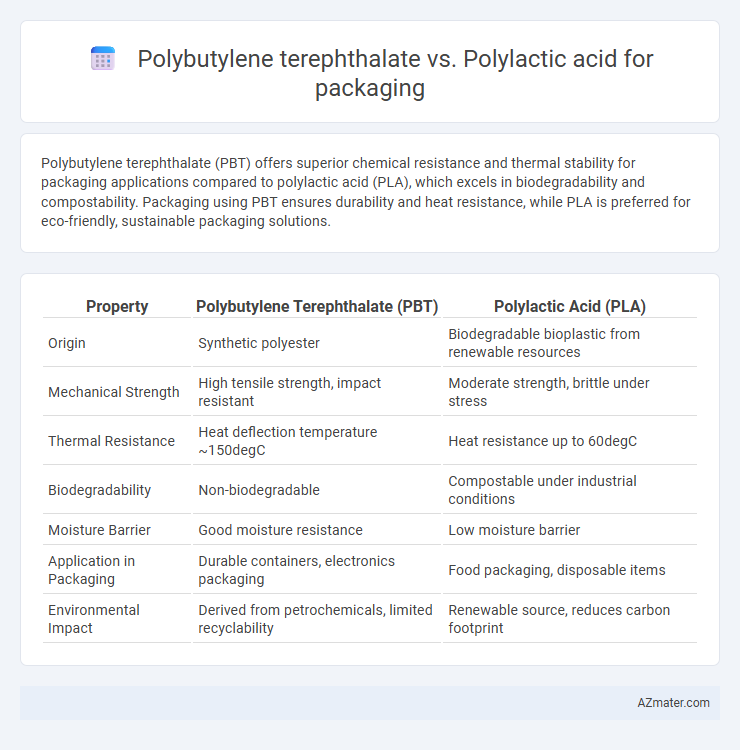Polybutylene terephthalate (PBT) offers superior chemical resistance and thermal stability for packaging applications compared to polylactic acid (PLA), which excels in biodegradability and compostability. Packaging using PBT ensures durability and heat resistance, while PLA is preferred for eco-friendly, sustainable packaging solutions.
Table of Comparison
| Property | Polybutylene Terephthalate (PBT) | Polylactic Acid (PLA) |
|---|---|---|
| Origin | Synthetic polyester | Biodegradable bioplastic from renewable resources |
| Mechanical Strength | High tensile strength, impact resistant | Moderate strength, brittle under stress |
| Thermal Resistance | Heat deflection temperature ~150degC | Heat resistance up to 60degC |
| Biodegradability | Non-biodegradable | Compostable under industrial conditions |
| Moisture Barrier | Good moisture resistance | Low moisture barrier |
| Application in Packaging | Durable containers, electronics packaging | Food packaging, disposable items |
| Environmental Impact | Derived from petrochemicals, limited recyclability | Renewable source, reduces carbon footprint |
Introduction to Polybutylene Terephthalate (PBT) and Polylactic Acid (PLA)
Polybutylene Terephthalate (PBT) is a durable thermoplastic polyester known for its high strength, chemical resistance, and excellent dimensional stability, making it suitable for rigid packaging applications. Polylactic Acid (PLA), a biodegradable biopolymer derived from renewable resources like corn starch, offers eco-friendly packaging solutions with good clarity and compostability. Both materials present distinct advantages in packaging, with PBT favored for durability and PLA valued for sustainability.
Chemical Structure and Properties Comparison
Polybutylene terephthalate (PBT) is a synthetic polyester known for its strong chemical resistance, high tensile strength, and excellent thermal stability, attributed to its aromatic terephthalate units combined with butylene glycol segments. Polylactic acid (PLA) is a biodegradable aliphatic polyester derived from renewable resources like corn starch, characterized by its lower melting point and reduced thermal stability compared to PBT, but it offers compostability and transparency ideal for eco-friendly packaging. The chemical structure of PBT provides enhanced durability and resistance to hydrolysis, while PLA's structure allows for easier biodegradation but limits its use in high-temperature packaging applications.
Mechanical Strength and Durability
Polybutylene terephthalate (PBT) exhibits superior mechanical strength and durability compared to polylactic acid (PLA), making it ideal for packaging applications that require high impact resistance and long-term stability. PBT's enhanced tensile strength and resistance to wear and chemical degradation allow it to maintain structural integrity under stress and varying environmental conditions. In contrast, PLA is more biodegradable but tends to have lower mechanical strength and is prone to brittleness, limiting its use in demanding packaging scenarios.
Thermal Stability and Temperature Resistance
Polybutylene terephthalate (PBT) exhibits superior thermal stability and temperature resistance compared to polylactic acid (PLA), with a melting point around 223degC making it suitable for high-heat packaging applications. PLA, derived from renewable resources, has a lower melting temperature approximately between 150-160degC, limiting its use in environments exposing packaging to elevated temperatures. The enhanced heat resistance of PBT ensures better dimensional stability and mechanical performance during thermal cycling in packaging processes.
Biodegradability and Environmental Impact
Polybutylene terephthalate (PBT) is a durable thermoplastic polymer with limited biodegradability, resulting in a longer environmental persistence compared to polylactic acid (PLA), which is derived from renewable resources like corn starch and decomposes more rapidly under industrial composting conditions. PLA offers significant advantages in reducing carbon footprint and reliance on fossil fuels, whereas PBT's production is more energy-intensive and contributes to microplastic pollution if not properly managed. The choice between PBT and PLA for packaging applications hinges on balancing mechanical performance with environmental sustainability, emphasizing PLA's superior biodegradability and lower ecological impact.
Barrier Properties: Moisture and Gas Permeability
Polybutylene terephthalate (PBT) exhibits superior barrier properties compared to polylactic acid (PLA), with significantly lower moisture and gas permeability, making it more suitable for packaging applications requiring long shelf life and protection against oxygen and humidity. PLA, while biodegradable and environmentally friendly, has higher permeability rates that limit its effectiveness in preserving sensitive products. Advanced PBT formulations offer enhanced resistance to gas and water vapor transmission, ensuring improved product integrity in demanding packaging environments.
Processing and Manufacturing Techniques
Polybutylene terephthalate (PBT) offers superior thermal stability and excellent moldability, making it ideal for injection molding and extrusion in packaging manufacturing. Polylactic acid (PLA), derived from renewable resources, requires lower processing temperatures and is compatible with extrusion, thermoforming, and blow molding, but it has a narrower processing window. Both polymers benefit from optimized drying and controlled cooling rates to enhance mechanical properties and minimize dimensional instability during packaging production.
Cost Analysis and Market Availability
Polybutylene terephthalate (PBT) offers a cost-effective solution in packaging due to its lower raw material expenses and established manufacturing infrastructure, whereas polylactic acid (PLA) typically incurs higher costs attributed to its biodegradable properties and reliance on renewable resources. PBT's market availability is extensive, supported by a mature supply chain in the petrochemical industry, while PLA, though growing rapidly, remains less prevalent due to limited production capacity and higher price points. Cost analysis reveals PBT as the preferred choice for high-volume, budget-sensitive packaging, contrasting with PLA's niche in sustainable, eco-conscious markets where price premiums are more acceptable.
Typical Applications in Packaging
Polybutylene terephthalate (PBT) is widely used in packaging for rigid containers, automotive parts, and electronic casings due to its excellent mechanical strength, chemical resistance, and thermal stability. Polylactic acid (PLA) finds typical applications in biodegradable packaging such as food containers, disposable cups, and films, favored for its compostability and renewable bio-based origin. While PBT offers durability for long-term use, PLA is preferred in eco-friendly packaging solutions targeting sustainability and reduced environmental impact.
Future Trends and Innovations in Sustainable Packaging
Polybutylene terephthalate (PBT) and polylactic acid (PLA) represent two pivotal materials in sustainable packaging innovation, with PLA gaining significant traction due to its biodegradability and renewable bio-based origins. Future trends emphasize enhancing PLA's thermal resistance and mechanical properties through advanced copolymerization and blending techniques to expand its application beyond food packaging. Concurrently, PBT is being optimized for recyclability and integration with bio-based monomers, promoting circular economy principles in high-performance packaging solutions.

Infographic: Polybutylene terephthalate vs Polylactic acid for Packaging
 azmater.com
azmater.com